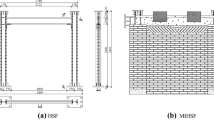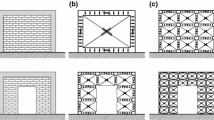Abstract
In the seismic analysis of a framed building with masonry infill walls, it is necessary to model the effect of the walls on the lateral stiffness, strength and ductility of the building. The equivalent strut method is convenient for modelling the walls in a large building. However, an appropriate axial load versus deformation relationship for the strut is required in a nonlinear static method of seismic analysis, such as the pushover analysis. The present study proposes a nonlinear axial hinge property for the strut, with suitable performance levels. First, the equivalent strut method and the suitability of two approaches available in the literature for modelling the properties of the struts, are briefly discussed. Next, the nonlinear axial load versus deformation relationship is developed based on experimental data compiled from the literature. The parabolic–plastic relationship is idealized as a tri-linear axial hinge property, so that it can be incorporated in commercial software for undertaking pushover analysis. Next, the use of the hinge property is demonstrated in the pushover analyses of two framed reinforced concrete buildings. The pushover curves based on the proposed hinge property shows improved modelling of the inelastic drifts of the buildings. Although the modelling of a wall using a single strut has limitations, the proposed methodology is practical for a pushover analysis of a building.











Similar content being viewed by others
Abbreviations
- B :
-
Breadth of section
- D :
-
Depth of section
- d :
-
Length of the equivalent strut, equal to the diagonal length of the infilled panel
- f a :
-
Allowable compressive strength along the diagonal of a wall based on slenderness ratio
- \( f_{bs}^{/}\) :
-
Design bond shear strength between masonry units and mortar
- h :
-
Height of centre-line of beam from top of footing
- h / :
-
Clear height of the wall
- l :
-
Centre-line to centre-line width of bay
- l / :
-
Clear length of the wall
- R :
-
Axial load in the equivalent strut
- R c :
-
Load in the equivalent strut at local crushing of the corners of the infill wall
- R s :
-
Load in the equivalent strut at shear cracking of the infill wall
- R dc :
-
Load in the equivalent strut at diagonal compression failure of the infill wall
- R u :
-
Ultimate strength of the equivalent strut
- t :
-
Thickness of wall
- α c :
-
Coefficient measuring the length of the wall in contact with the column
- δ :
-
Axial deformation of the equivalent strut
- ε :
-
Axial strain in the equivalent strut
- ε 0 :
-
Strain in the equivalent strut when the strength is attained (R/R u attains the value of 1) = 0.0025
- ε u :
-
Strain in the equivalent strut till the strength is retained = 0.004
- ε 1, ε 2 :
-
Strain in the equivalent strut at the diagonal compression failure of a slender infill wall
- ϕ :
-
Diameter of bars
- μ :
-
Coefficient of internal friction between masonry units and mortar
- θ :
-
Angle of inclination of diagonal of the panel, with respect to horizontal
- θ eff :
-
Angle of inclination of strut considering the length of wall in contact with the column
- σ c :
-
Average normal stress on wall in contact with column
- τ b :
-
Average shear stress on wall in contact with beam
References
Achintya, P. Dayaratnam, S.K. Jain, Behaviour of brick infilled RC frame under lateral load. Indian Concr. J. 65(9), 453–457 (1991)
H. Achyutha, S.S. Injaganeri, S. Satyanarayanan, C.S. Krishnamoorthy, Inelastic behaviour of brick infilled reinforced concrete frames. J. Struct. Eng. 21(2), 107–115 (1994)
P.G. Asteris, S.T. Antoniou, D.S. Sophianopoulos, C.Z. Chrysostomou, Mathematical macromodeling of infilled frames: state of the art. J. Struct. Eng. 137(12), 1508–1517 (2011)
Davis, R., Menon, D. and Prasad, A. M., 2008, Evaluation of magnification factors for open ground storey buildings using nonlinear analyses, Proceedings, 14th World Conference on Earthquake Engineering, Beijing, P. R. China, October 12–18
FEMA 356, 2000, Prestandard and Commentary for the Seismic Rehabilitation of Buildings, Federal Emergency Management Agency, USA
M. Holmes, Steel frames with brick and concrete infilling. Proc. Inst Civil Eng. 19(4), 473–478 (1961)
IS 1893: 2002, Indian standard criteria for earthquake resistant design of structures, Part—1. General provisions and buildings, Bureau of Indian Standards, New Delhi
T.C. Liauw, K.H. Kwan, Unified plastic analysis for infilled frames. J. Struct Eng. 111(7), 427–1448 (1985)
A.B. Mehrabi, P.B. Shing, M.P. Schuller, J.L. Noland, Experimental evaluation of masonry-infilled RC frames. J. Struct. Eng. 122(3), 228–237 (1996)
A.B. Mehrabi, P.B. Shing, Finite element modeling of masonry-infilled RC frames. J. Struct. Eng. 123(5), 604–613 (1997)
Polyakov, S. V., 1963, Masonry in framed buildings, Godsudarstvenoe Isdatel’ stvo Literatury Po Stroidal stvui Architecture, Moscow, Translated by G. L. Cairns, National Lending Library for Science and Technology, U. K
A. Saneinejad, B. Hobbs, Inelastic design of infilled frames. J. Struct. Eng. 121(4), 634–650 (1995)
SAP, NL (Computers and structures incorporated, Berkeley, 2000)
A.K. Sengupta, A. Asokan, Modelling of infill walls for nonlinear static analysis of buildings subjected to seismic loads. Indian Concr. J. 82(2), 19–28 (2008)
B.S. Smith, C. Carter, A method of analysis for infilled frames. Proc. Inst. Civil Eng. 44(1), 31–48 (1969)
Author information
Authors and Affiliations
Corresponding author
Rights and permissions
About this article
Cite this article
Adukadukam, A., Sengupta, A.K. Equivalent Strut Method for the Modelling of Masonry Infill Walls in the Nonlinear Static Analysis of Buildings. J. Inst. Eng. India Ser. A 94, 99–108 (2013). https://doi.org/10.1007/s40030-013-0042-y
Received:
Accepted:
Published:
Issue Date:
DOI: https://doi.org/10.1007/s40030-013-0042-y




